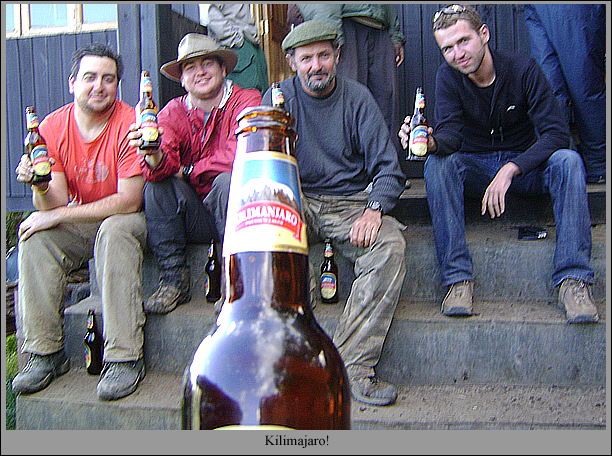BootsnAll 2008/9 New Year Summit
There is a lot to be said for being among the first batch of climbers to summit a big mountain in any given year, and a lot also for watching the first sunrise of a new year from the roof of any continent. This is especially so after an emotionally and physically challenging climb which, despite what is commonly reported about Kilimanjaro, is no walk in the park. Kilimanjaro is a magnet for lay climbers from all over the world, mainly because it has no technical aspects, however it soars to almost 20 000ft above sea level, and no climber, be they novice or veteran, can achieve that kind of altitude without some pain.
What makes Kilimanjaro such a powerful draw is also what makes it such a unique challenge. A question to ask yourself when evaluating the individual courage that it takes for a novice to suceed is this: ‘Is it more impressive for someone wholly fit and acclimatized to stroll to the summit with ease, or for someone who had no idea what to expect, was never really mountain ready, but who by the sheer force of will and desire defied the odds and made it to the top anyway?’
You decide…I know what I think!
Clockwise from left: Bob, Dave, Twiggy, Joe, ‘Obama’ Sam, Robbin, Marlene and Oskar…
The first to sign up for the 2008 summit was Robbin Jordan, a Human Resources Officer with the US Liver Foundation in New York, for whom summiting Kilimanjaro stood at the top of a list of conquests she was determined to achieve before turning forty. She also signed up her over-forty significant other, Sam Williams, an ex-Army drill sergeant, and a man who had clearly nothing left to prove in terms of stamina and self reliance.
Robbin’s email moniker is painintheass.com, which has a defiant feeling about it that seemed at the time to offer mixed omens to the prospects of our evolving group. The same was true for our next climber, Marlene Brown, a new-age traveler from New Mexico who goes by the handle of wildwoman.com. Fortunately Robbin turned out to be much less than a pain-in-the-ass, and if Marlene is a wild-woman she managed to keep the beast caged on this trip.
Behind Robbin and Marlene in a queue of women with mountains to climb came Gurleen ‘Twiggy’ Tirwana, a Virginia appointments executive who had a dream one night that she was standing on the summit of Kilimanjaro, a challenge she accepted. A combination of work, a family bereavement and a butterfly sensibility kept Twiggy’s attendance in doubt until the last minute when she stepped off the Precision Air flight from Dar es Salaam and strolled into the Kilimanjaro International Airport arrivals hall.
Bob Holdsworth has the air about him of a spiritual traveler. A man over fifty with a life well lived and a world yet to see. He threw a dart at the map for the sake of a different travel experience and scored a direct hit on Kilimanjaro. After a quick phone call, and a minimum of reflection, it was a case of Bob’s your uncle!
Next came an inquiring note from a certain polish wunderkind whose tender years seem to do no justice to his intellectual and social accomplishments. Before too long Oskar Tetzlaff, with his encyclopedic hard-drive and indestructible self confidence, was amongst us.
Lastly came the James brothers, Joe and Dave, two laconic Texans with a sparse turn of phrase and a shared humor of the quick and lively type. Joe hovered on the brink for a week or two before committing, and during that time I gave up on them both, and looked around for some other leavening to thicken the loaf, but fortunately for us all Joe and Dave signed up, and then we were nine!
Moshi and the Mountain
 Oskar and I arrived in Moshi a few days ahead of the others. For me it was an opportunity to conduct a quick tour of inspection of the BootsnAll mountain and safari program, which is an excuse if one is ever needed to bounce around the countryside in an air-conditioned safari Landcruiser. This difficult job also involved checking in at all the listed hotels and lodges and stopping for an occasional cold Tusker in any likely looking bush boozer along the way. The warm tropics are after all never short of opportunity to explore the local hostelries and brews.
Oskar and I arrived in Moshi a few days ahead of the others. For me it was an opportunity to conduct a quick tour of inspection of the BootsnAll mountain and safari program, which is an excuse if one is ever needed to bounce around the countryside in an air-conditioned safari Landcruiser. This difficult job also involved checking in at all the listed hotels and lodges and stopping for an occasional cold Tusker in any likely looking bush boozer along the way. The warm tropics are after all never short of opportunity to explore the local hostelries and brews.
Kilimanjaro is ringed by a belt of tropical forest that has these days diminished to little more than a narrow strip under direct KINAPA protection. Beyond this a sprawl of smallholder properties has grown up in the last century to occupy every inch of available space. The result is a uniquely beautiful but densely compacted human conurbation, intermingled with cultivated groves of coffee and banana, roadside villages, colorful homesteads and occasional towering forest trees, all of which are stitched together by mixed gardens of flagrant color and wild indiscipline. It is a uniquely African environment, chaotic, unkempt, noisy and vivacious. Here and there a hotel or lodge lies nestled in a quiet corner, but the energy of life – plant, animal and human – resonates like a ringing in the ear, and is never too far away.
Further down the mountain slopes lies Moshi town itself. The downtown district is set in a dry depression that could hardly be further removed from the tropical verdure of the mountain foothills just a few miles away. It is a noisy, dusty and energetic little town in the grand old African tradition of civic decomposition. The traffic is dirty and chaotic and the shop fronts clogged with humanity. Tiny stall-like shops all seem to sell the very same merchandise as the street touts who stand with their boards of cheap Chinese wares on almost every street corner.
Despite this there is no stress associated with a walk around downtown Moshi. Foreigners are plentiful hereabouts, and even the street sharps and safari touts tend to adopt a low pressure sales policy. So different it is from such hot-beds of petty theft and villainy as Nairobi or Dar es Salaam. At propitious moments Kilimanjaro looms over the bustling town as if to remind the unwary that the contest awaits. Mostly however the mountain lies swathed in mist and cloud, and is usually invisible from the bustling town.
An Unlikely Mountain Town
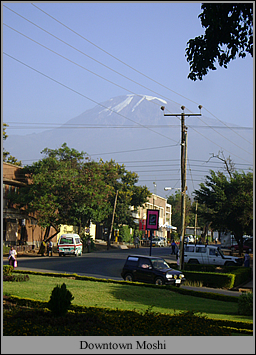 Under the soft grip of the tropics it is easy sometimes to forget that Moshi is a mountain town. There are no outdoors emporiums here, nor any bars or restaurants with any discernable mountain theme. Kilimanjaro is largely the playground of foreigners, for no diligent local would waste his time and money to climb it. There is no local culture of mountaineering other than that prompted by tourism, and even that has more of a journeyman feel about it than any sense of passion for the pursuit of mountaineering.
Under the soft grip of the tropics it is easy sometimes to forget that Moshi is a mountain town. There are no outdoors emporiums here, nor any bars or restaurants with any discernable mountain theme. Kilimanjaro is largely the playground of foreigners, for no diligent local would waste his time and money to climb it. There is no local culture of mountaineering other than that prompted by tourism, and even that has more of a journeyman feel about it than any sense of passion for the pursuit of mountaineering.
The Crew
This is nowhere more evident than at the National Park gates as the porters arrive in busses to descent like a flock of starlings on a disordered pile of kit. These are definitely not mountain men. They are a workforce of itinerate individuals who show up when they need to and do not when they don’t. For those of us standing around watching, and we were the only group at the Londorossi Gate in Western Kilimanjaro on that day, it is hard to imagine that all these people could have assembled simply to facilitate our comfort.
Our porters were the usual motley collection of men in outfits of a distinctly lowland flavor. For a long time they were tightly compacted around the scales as loads were assigned and weighed. Out of chaos comes order, and as we signed in at the desk, and adjusted our very minimal packs, bundles were formed and assigned their places, and in due course each porter was loaded rather unfairly, it seemed, and sent off up through the forest to disappear into the gloom way in advance of the climb party.
 Our guides for this trip were Joshua and Eugene, two of Kilimanjaro’s salted veterans, and a pair of mature gentleman far removed from the crude and rude youth that often pose as guides in these parts. Both men have been working this route for well over a decade, and neither can accurately remember just how many times he has summited.
Our guides for this trip were Joshua and Eugene, two of Kilimanjaro’s salted veterans, and a pair of mature gentleman far removed from the crude and rude youth that often pose as guides in these parts. Both men have been working this route for well over a decade, and neither can accurately remember just how many times he has summited.
Miti Mkubwa
The refreshing thing about coming in from the west via the Londorossi Gate is that for the first couple of days the trail is quiet. By then we have all begun to bond, particularly after a few nights on the town, and another few days on safari. We are all accepting of the challenge ahead…if not ready, then at least prepared for the shock.
And mild enough a shock it turned out to be. The opening sequence of the Lemosho Route amounts to little more than an easy two hour amble upwards through the forest, challenged now and again by no more than mud or a slick trail. This is a fact of life shared by the elusive forest elephant who leave deep skid marks on the trail as they clearly also struggle for purchase after a rain shower. It is comforting to think that they perhaps also occasionally lose their footing and tumble into an unruly heap at the bottom of a gully.
First night camp is Miti Mkubwa, or Big Tree Camp, which is really no more than a clearing on a wooded knoll sited midway up the heavily forested western flank of Kilimanjaro. It is dominated by a large podocarpus tree and a lonely park rangers hut around which every night a small village of tents arises.
When I arrive I see Bob in the center of the clearing, surrounded by the hubbub of porters assembling camp, his arms akimbo and his lungs awash with champagne air. ‘This is just a little piece of heaven.’ He marvels, feeling thoroughly invigorated. Like us he has only been comfortably challenged by this the first mild stretch of our six-day climb.
Shira
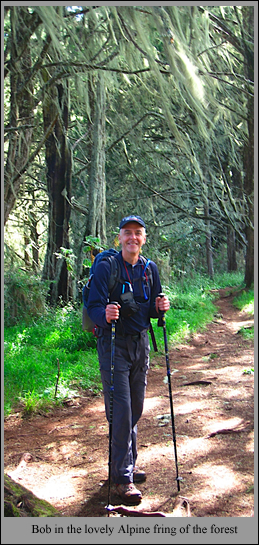 Day two continues upward from Miti Mkubwa Camp with the forest beginning to change character slightly to become dominated by the giant forest juniper, or Juniperus procera, that are strung with lichen and give the forest a strangely moody and temperate appearance. Soon however the trail breaks out of the canopy and settles into a curious landscape of diminutive cedar groves tightly compacted and called for convenience the Heather Belt. This is a uniform type of bush about head high in places, and fluoresced very subtly by Protea bushes and an occasional sprinkling of pin-flowered ericas tucked away into sun sparse corners.
Day two continues upward from Miti Mkubwa Camp with the forest beginning to change character slightly to become dominated by the giant forest juniper, or Juniperus procera, that are strung with lichen and give the forest a strangely moody and temperate appearance. Soon however the trail breaks out of the canopy and settles into a curious landscape of diminutive cedar groves tightly compacted and called for convenience the Heather Belt. This is a uniform type of bush about head high in places, and fluoresced very subtly by Protea bushes and an occasional sprinkling of pin-flowered ericas tucked away into sun sparse corners.
The trail veers northeast towards the leading edge of the Shira Crater, and after a breathless series of ridge climbs it descends onto the Shira Plateau where in the distance the featureless Shira Camp hosts its usual nocturnal colony.
Shira 1 Camp sits at the western edge of the Shira Crater, the oldest of the three main volcanic features of the mountain, and within which the undulating expanse known as the Shira Plateau leads up to the first of the steep steps that form the beginning of the main Kibo Crater. The camp itself is like most of the larger camps – for here the drive-in Shira Route is dumping ever more packs and more porters, and the dozen or so latrines that mark the immediate landscape lend the air a particular aroma. The wide camping area is littered and noisy, and strewn with tents, bundles of kit and porters. Once again the air is alive with chatter, transistor radios and the occasional whir of wings as ravens move to and fro through the social mass in search of scraps.
Day two has been a significantly harder push than hitherto. As dinner evolves within a large bell-tent – wherein all 32 porters are noisily ensconced – we all stand around in various postures of anticipation. Iin the distance a thick swaddling of cloud occasionally parts to reveal a portion of the glaciered slopes of Kibo. After supper it is an early night. This is testimony to fact that the game is on. Tired limbs demand rest. It is only during the midnight visits, under a sky so clear that you can almost run you fingers through the stars, that the first dramatic display of the glacier encrusted peaks of Kibo appear in total to both tempt and terrorize.
Such fears are of course absent during the day. Sunshine washes clean the valleys and ridges, and melts the icy pools and the hoar encrusted tents. In the far distance Kibo looms in sunlit clarity, seemingly closer than before, not particularly intimidating, and significantly less haunting than she appears under moonlight.
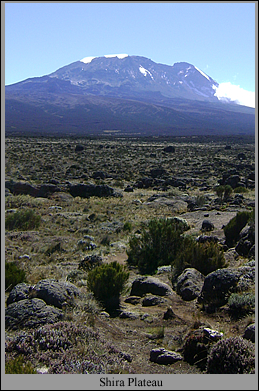 Daylight humor begins again at the breakfast table. My predictions was then that the easy atmosphere evolving between us would evaporate as altitude and exhaustion pared away at our reserves. This usually happens, but for the moment we are all friends, and the group strings out in friendly parties over the easy expanse of the Shira Plateau.
Daylight humor begins again at the breakfast table. My predictions was then that the easy atmosphere evolving between us would evaporate as altitude and exhaustion pared away at our reserves. This usually happens, but for the moment we are all friends, and the group strings out in friendly parties over the easy expanse of the Shira Plateau.
This is one of the most beautiful quadrants of Kilimanjaro. Its beauty is enhanced by the fact that it is easy, the weather is warm, and the gradient shallow. By early afternoon we are in camp, and again just occasional glimpses of Kibo appear through the afternoon cloud.
Shira 2
From Shira 2 a more serious air of endeavor begins to take hold. The trail veers directly towards the mountain with a long and steady climb that soon begins to wear on the ankles, and prompt a suspicious shortening of breath and a slight throb in the temples. At some 15 000ft, and after a three or four hour steady trudge, the trail weaves around the Lava Tower and into a campsite that has seen better days. Lava Tower Camp is a nasty place, liberally strewn with trash and malodorous from poorly sited and ill maintained latrines. This is the reality of altitude. All standards of health, decorum and commitment begin to decline. It is with evident relief that our party of sober climbers begin the rapid descent to the Barranco Camp at around 12 000ft to begin the serious business of altitude adjustment.
Barranco
Barranco Camp is situated in an extraordinarily dramatic location. It lies at the foot of the Western Breach, tucked close to the skirts of Kibo, and walled in on either side by the great Barranco that offers and easy turn neither to the left nor the right. From below access is only via the narrow line of the Umbwe Trail which is the stiffest and shortest of all the access trails to Kilimanjaro. Stranded in the lap of this great geographic feature the heavily glaciered dome of south Kibo looms in suddenly exaggerated dimension. As the clouds skid and wane a little of it at a time becomes visible. No clear views of course, that is strictly for mid-night contemplation, for those moments as you stand and pee into a frozen puddle, and shiver in the open just long enough to be awed.
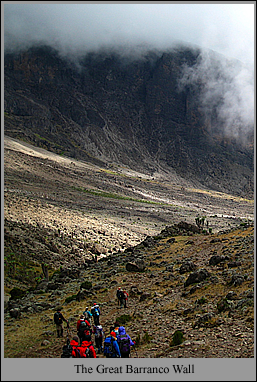 The Barranco Wall, a 2000ft face, presents a fearsome sight over the rim of a coffee cup as the facts of the day begin to dawn. By 08:00 a ribbon of whooping and whistling porters is strung from top to bottom, as these irrepressible souls illustrate to the over-equipped just how easy this all is.
The Barranco Wall, a 2000ft face, presents a fearsome sight over the rim of a coffee cup as the facts of the day begin to dawn. By 08:00 a ribbon of whooping and whistling porters is strung from top to bottom, as these irrepressible souls illustrate to the over-equipped just how easy this all is.
As we start up the wall it seems less daunting than it first appeared, and is in fact just a long and steady trudge that consumes much less of our vital reserves than would earlier have seemed reasonable.
Karanga Camp
The next stop is Karanga Camp, not too far away, and only a little higher. By now exhaustion is deep seated and the wear and tear is beginning to show. Diamox keeps the worst of it at bay, but for those without, or determined to do without, the headaches are continuous and motivation thinning as perceptibly as the air.
Karanga Camp is precipitously poised along a narrow ridge, with the looming face of Kibo behind, Mount Meru to the fore, and the lights of Moshi and Arusha spreading in between. It goes without saying that; as darkness cloaks the mountain; as the congestion of climb parties merging towards the summit grows; and as the wind only briefly diverts the smell from the latrines, that the whole scene is beautiful, and even enchanting. With the proximity of New Years Eve, and the big push for the summit, it is also more than a little scary.
Barafu Camp
Barafu Camp is a hectic concentration of hundreds of tents spread over a ridged finger of slate and scree in the lifeless high desert. The glaciered flanks of Kibo look deceptively close, and friendly, but this is no pleasant place. It is a staging post, noisy, odorous, predatory and determined. Hundreds of climbers, and many, many more support staff jostle and squabble for limited space. Everybody endeavors to bunk down as early in the day as possible. Today is the day of the midnight wake up call and the solid six or seven hour, 4000ft slog to Stella Point, and then the summit.
No one sleeps of course, and the wake up call in unnecessary. Our ascent has been staggered, and besides which the hundreds of porters and guides billeted within a mile radius of camp keep up a steady clamor until a dam burst of noise and cheering in the darkness greets the bewitching hour.
Oskar, characteristically, made the noble determination that he would be the first to the summit in 2009. He left for the summit at 22:00, two hours early, with Twiggy, unsurprisingly daring and reliant, keeping him company. They both made the summit, and apparently they were indeed the first of 2009 to reach it.
Meanwhile an hour later Sam and Marlene set off into the bleak and freezing night, slower than the rest of us, and eager for a little advantage. Then, more or less at the point of midnight, those remaining plod off into the darkness and join a narrow line of blinking head-lamps rising like a dizzy spiral into the infinite darkness.
The Summit
These are moments that have no fireside relevance. No evening spent sitting around the pub chatting about it to friends can really capture the oddly surreal mood that grips a person locked into this strange endeavor. Picture the darkness and the increasingly bitter cold. The exhaustion, the anxiety, the temptingly hypnotic rhythm of one foot slowly placed before the next. One light ahead and another behind. Pole-pole (Swahili: slowly-slowly). One step at a time. Breathing is hard, concentration total, humor evaporated and well-being a distant memory. Someone has collapsed on the right while someone else is patting warmth into their hands and whispering urgent pleas. Who cares? Onwards and upwards. One foot in front of the other. So this is how those terrifying stories of climbers dying and being left to die on Everest play out? Who cares if he or she expires right there? Leave her…or him. It is a tough call…but really who cares?
Then Robbin suddenly staggers and collapses. This is a terrible moment. If there was one person more than any other among us who had a deadline to do this thing it was she. This she had to do before she turned forty. Time waits for no man…or woman. It was fortunate that she fell back in a cleft of rock, and did not stagger over the skree and fall.
There is no wrong decision in a situation like this. She knew it, and we knew it, and after a brief protest she turned around and set off back down in the company of a guide. The reasoning was simple. An injury here is a death sentence. Within 20 minutes or less she could have frozen to death waiting for a rescue. The water in our water bottles was solid. Hands were frozen and hypothermia just a lingering moment away.
One foot in front of the other. Pole-pole. We set off again with the merest band of pink on the eastern horizon that brought vaguely into view the broken peaks of Mawenzi. There is no time to admire the Rebmann Glacier looming dense and cold on the left, nor the blossoming sunrise to the right. One foot in front of the other. Pole-pole. That is all.
We caught up with Sam dragging himself inch by agonizing inch towards Stella Point. These last few hundred yards are more than exhausting. Exhaustion is by now an already familiar sensation. This is the difference between starvation and a healthy appetite, between excruciating pain and a mild discomfort. This is what afflicts souls in extremis in the seconds before dying. It is the moment that the deepest reserves are tapped, and the last precious drops of determination are measured out step by painful step…pole-pole…one foot in front of the other.
From Stella Point a 45 minute trudge remains along the rim of the crater, and up a gentle but desperate incline. A wide gravelled trail leads to the gallows-like marker of Uhuru Peak. All the way up the merry souls on the downward journey swear to you that you can make it. ‘…you’re almost there!’ they merrily quip, and if any strength remained in me to utter words ‘…go fuck yourself!’ I would have.
And then suddenly you have made it! It is new years day and hundreds of people have succeeded. The sun is sending oblique rays through the thin air and illuminating happy faces with a curious custard hue. A quick queue for photographs. Hands hurriedly exposed to the freezing wind. Then 180 degrees turnaround and back down the slope…we are all now one of the merry ones: ‘…you can make it…you’re almost there!’ A steady stream of last-chancers plodding the desperate half mile utter their own half formed expletives. Each with the 7000-yard stare. Each placing one foot in front of the other. Pole-pole.
Home For Some
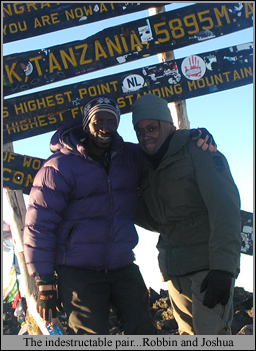 Back at Barafu there is to be 90 minute rest before fleeing to the lower altitude of Mweka Camp.
Back at Barafu there is to be 90 minute rest before fleeing to the lower altitude of Mweka Camp.
Restless in her tent was where I found Robbin. She had meekly accepted the inevitable but had nonetheless devised an alternative plan on the way down. She was naturally reconciled to what had earlier happened, but she had not eaten at midnight and had left ill prepared. It was a mistake she had rrectified. She had eaten and rested, and she was recovered. Could she try again?
It was a puzzling question. Try again? You mean next year? In a few days? No, she said, right now!
I was astonished. What an audacious idea! People like Robbin are not easily diverted. She is a quiet woman, and acute testimony to the fact that still waters run deep. A quick query and the promise of reward prompted Joshua to volunteer to guide her back up. Then, for the second time that day, and leading a women more determined in aspect than any I have ever seen before, the indestructible Joshua set off towards the summit.
It was noon by then and the rest of us packed up and set of on a downward trajectory towards the the green forest and an accommodating altitude. It was another long and thankless trudge, merry thanks to having done the job, but wobbly after no less the 12 hours of solid endeavor. Soon enough however we were keeping the bottle porters running between the village pub and Mweka Camp, having traded the Kilimanjaro of rock and ice for the label on a warm brown bottle of beer.
At about 03:00 the following morning I heard Robbin arrive back in camp. I heard her grunt a few words to Sam before her lights went out. It was morning before I discovered that she and Joshua had summited just before sunset, before then turning around for the solid eight hour hike to join us at Mweka Camp.
So the toast of the trip goes to Robbin Jordan for that epic performance, and to ‘Obama’ Sam for making it as far as Stella Point. For the others – Bob (Bobu) Holdsworth, Marlene Brown, Dave and Joe James, and Twiggy and Oskar, thanks for a fabulous trip, and great company, rich in questionable humor, but humor all the way: and thanks for making the trip a success. Here’s to 2009/2010!
Thanks mainly to Bob for the pix




